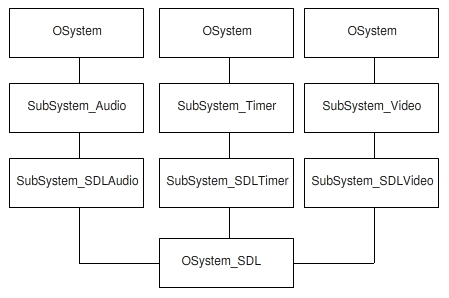The idea and goal
My first task is refactoring the backend structure. It has to be designed in a way to improve portability and make it easier to modify. Also, it has to allow an easy and fast way to use different libraries in platforms. This is mainly for making the next task, implementing OpenGL, easy to port.
OpenGL is only a specification for rendering, and does not include Audio playing, timers, devices detection, and else functions that a library like SDL does have. So, the goal is to be able to use OpenGL for rendering and SDL for the other tasks, or other libraries/sdks if needed.
Now, the idea is to create a backend structure based on independent subsystems. Then, we can use the audio, timer, events, and else subsystems from SDL, and use the rendering subsystem from OpenGL.
Planed design
Each backend, like for example the SDL one, will inhereit from its subsystems that already inhereit from their virtual subsystem classes. And each subsystem will inhereit from the OSystem class.
 Example class diagram
Example class diagram
In the example diagram, SubSystem_Audio, SubSystem_Timer and SubSystem_Video are the virtual structure for the SubSystem_SDL* classes. The virtual subsystems will inhereit virtualy the class OSystem, then OSystem_SDL will only include one copy of OSystem. In actual ScummVM code, OSystem_SDL overrides all OSystem functions; in the planed desing, the OSystem functions will be mostly overriden by each subsystem, and only initialization or other special codes will be included in the OSystem_SDL backend.
An idea I have in mind is also to separate the platform specify codes in OSystem_SDL, and create for each platform a new OSystem_*Platform* class that would inhereit the subsystems it needs. Then, we will have OSystem_Win, OSystem_Unix, OSystem_Mac, and else insteand of OSystem_SDL. This will help when implementing the OpenGL subsystem, as it will only be needed to change the inhereited video subsystem in the platform, and as the SDL name in the class doesn’t reflect OpenGL is being used.
04 |
class SubSystem_Timer : public virtual OSystem { ... |
05 |
class SubSystem_Audio : public virtual OSystem { ... |
06 |
class SubSystem_Video : public virtual OSystem { ... |
09 |
class SubSystem_SDLTimer : public SubSystem_Timer { ... |
10 |
class SubSystem_SDLAudio : public SubSystem_Audio { ... |
11 |
class SubSystem_SDLVideo : public SubSystem_Video { ... |
14 |
class SubSystem_OpenGL : public SubSystem_Video { ... |
17 |
class OSystem_Platform1 : public SubSystem_SDLTimer, public SubSystem_SDLAudio, public SubSystem_SDLVideo { ... |
20 |
class OSystem_Platform2 : public SubSystem_SDLTimer, public SubSystem_SDLAudio, public SubSystem_OpenGL { ... |
